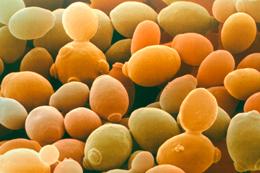Sep
20
The First Synthetic Yeast
September 20, 2011 | 2 Comments
Fermentation has relied on natural yeasts for centuries – now researchers at John Hopkins University School of Medicine have equipped yeast cells with semi-synthetic chromosomes. It is the first such achievement in eukaryotic, or complex-celled, organisms, and marks a step towards large-scale genome engineering in these cells with synthetic biology.

Yeast cells can live quite happily with a partially synthetic chromosome. Image Credit Science Photo Library.
The full paper is now up at Nature with the suggestion that these genetic engineered yeast strains are just as healthy as natural yeast. Its been expected and now its been accomplished.
Ready for the kick? The engineered strains also have a built-in ‘scrambling’ system that deletes and shuffles random genes on demand – a feature that could prove useful for developing yeast optimized for the production of fuel, drugs or other valuable chemicals. The team’s eventual goal is to synthesize the entire yeast genome.
Peer acknowledgment pre-publication are turning up. Andy Ellington, a biochemist at The University of Texas at Austin, who was not involved in the work said in the Nature pre-publication news announcement, “It appears to be fantastically stable, At least some of us thought that it would fall flat on its face or would mutate quite readily.”
Scientists have previously built and engineered entire genomes, but generally in simpler organisms, such as bacteria. To date the biggest genome synthesized is that of the bacterium Mycoplasma mycoides, the roughly 1 million base pairs of which were mostly a replica of the natural sequence in a study published last year. Scientists have also made genome-scale changes to viruses, and have removed unnecessary genetic elements, and replaced sequences across bacterial genomes.
Yeast biologist Jef Boeke and his colleagues tackled two chromosome segments that together represent about 1% of the 12-million-base-pair genome of the yeast Saccharomyces cerevisiae. They designed the synthetic segments with the help of genome-editing software, incorporating several types of changes.
The changes included removing repetitive sequences that could destabilize the genome, and adding tags to distinguish synthetic segments from natural ones. To create the genetic scrambling system, the team inserted short sequences that act as binding sites for a specific enzyme, which can delete or rearrange genes if activated. Overall, the researchers changed about 17% of the sequence in the targeted segments.
Then the edited segments were synthesized and introduced into yeast cells, replacing the corresponding natural segments. Tests showed that the resultant semi-synthetic strains had apparently normal growth rates, colony appearance and gene expression. When the researchers turned on the scrambling system by activating the necessary enzyme, they were able to generate mutant strains with varying growth rates, drug sensitivity, temperature sensitivity, use of carbon sources and stress responses.
Boeke says that when more of the yeast genome is synthesized, researchers will be able to use the system to study evolution and speciation. For example, they could delete genes to determine how much of the genome is needed for survival, or see how much genome scrambling it takes to produce a new species. Things are going to progress much faster now.
An involved colleague Ham Smith, a molecular biologist at the J. Craig Venter Institute in San Diego, California prepared a statement saying Boeke’s work is, “another remarkable example of how synthetic biology can be used to rewrite chromosome sequences at a sizable scale.”
The scientists foresee and understand the up coming problems. Smith noted that it is unlikely that any cells would survive if the scrambling system were extended over substantially larger parts of the genome. Boeke says that reducing the length of time for which the scrambling system is activated, and weakening the enzyme’s expression could address this problem.
More good news – Boeke reports the team has enlisted undergraduate students John Hopkins to construct pieces of the rest of the yeast genome. Students and researchers in China might also join the effort.
Although it will take several years to build the whole synthetic genome, Boeke estimates that so far, the team has synthesized the DNA pieces for about 10% of the genome, and about 2% have been tested in yeast.
This is remarkable news. One assumes that the documentation of the work will open a major resource for the use of yeast in industrial applications. It might not seem like a big deal for the immediate future, but this is a major step that has been eagerly anticipated for years.
It will be a while until results get into mass production and we may not even be told of the connection to this seminal work. So lets get congratulations on record – that is well deserved.
Comments
2 Comments so far


Maybe it is just me, but I keep waiting for someone to create a yeast that feeds on cellulose – that accidentally turns all the woodframe houses in this country into biofuel.
The advancements they are doing with synthetic sciences are pretty amazing. Yeast is just the beginning.